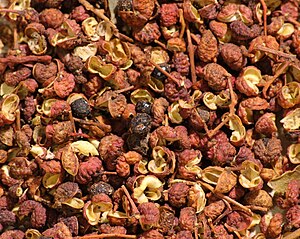
- Image via Wikipedia — Szechuan pepper
Szechuan pepper is a spice that comes from plants of the Zanthoxylum genus that are native to Asia. Although the name includes the term ‘pepper’, these plants are not related to black pepper or chili peppers. All Zanthoxylum species belong to the citrus family, Rutaceae. Several species may be used as the source of the spice with Z. piperitum and Z. bungeanum being the most-often cited.
The spice comes from the dried, small round berries. These fruits are dried to separate the outer fruit covering or pod from the seeds. Seeds are not used in cooking because they produce a gritty texture. The spice is contained in the pod which has a lemony or citrus-like aroma. The foliage is said to have a taste between lime and mint. Leaves are used in local cuisines where the trees grow.
Szechuan pepper is not a pungent spice, so even though it’s called a pepper it doesn’t have the same heat or hotness that is experienced when eating black pepper or chili peppers. The pepper name refers to a tingling, ‘pins and needles’ sensation that is felt on the tongue and lips. The taste dissipates to a subtle sweetness. Essential oil content of the pods is about 3%, consisting primarily of hydroxy-alpha-sanshool, which is responsible for the tingling sensation.
A closely related tree in North America is called prickly ash, Z. americanum. The name prickly ash refers to the stout spines found on the trunk and branches, a characteristic shared by other members of the genus. Prickly ash is also known as the ‘toothache tree’ because the bark, leaves and fruit pods are very aromatic. They contain a numbing substance, xanthoxylin, that was once used to treat toothaches simply by chewing on twigs or bark of this small tree.
Szechuan pepper is used to flavor dishes cooked in the style of Chinese province with the same name. Szechuan may also be spelled szechwan or sichuan. It’s known as Chinese pepper and Japanese pepper as these cuisines often use it as flavoring. Szechuan pepper is an ingredient in authentic Chinese five spice powder.
Chinese restaurants in the United States typically have menus divided into sections based on regional cooking styles in China. Szechuan-style cooking is regarded as hot and spicy and often noted on menus with red lettering or asterisks and footnotes.
For several decades Szechuan peppers were not allowed to be imported into the United States. The plant material is a carrier of a bacterium that causes citrus canker. Citrus canker is a disease that is contagious to other citrus family members, especially citrus fruits. The leaves and fruits of commercially important citrus trees are affected and there is no cure. The import ban was lifted in 2005 for szechuan pepper that has been subjected to a heat treatment of 70 degrees Celsius to kill any bacteria.

can you tell me how to eradicate the gritty texture when cooking with sichuan peppers?
it seems that they only come packaged dried and husked but there is still an amount of peppercorns inside.
i look forward to hearing from you.
Hey Renata,
If the seeds don’t shake loose from the peppers, try chopping them on a cutting board. You can get a lot of the seeds to stay behind by scraping your knife at a cross-wise angle across the chopped peppers. If that doesn’t take out enough of the hot seeds, then make a paste with the chopped sichuan peppers by adding a little vinegar or broth. Add just enough liquid to get the peppers into solution so you can then decant the peppery liquid into another dish. The seeds should remain (mostly) on the bottom of the liquid preparation and therefore be left behind.
Those are the steps I’d try, but we like the hot seeds in the food and don’t fuss with taking them out. To each their own, right?
Have fun and good eats!
“For several decades Szechuan peppers were not allowed to be imported into the United States”
I grew up knowing Szechuan style to mean simply “hot”. Recently I had a dish that was “hot and numbing” at the same time – but there was no noticeable ingredient. After reading this I realize the dish had the oil rather than the whole berry. I wasn’t expecting the numbing/tingly sensation and almost sent the dish back since it was so different from past versions of Szechuan Beef. More authentic, I suppose. But I will stick to Hunan style.
Hi Matt,
Yeah, I guess you could call Szechuan-style food “really hot!” I think Hunan-style is too plain as I like things a bit spicy, so I go for Szechuan. If the menu doesn’t have red lettering or a little icon of a hot pepper for the dish, you should be ok to try other styles.
That’s a great observation that the fiery hot oil can be in a dish so there’s no noticeable peppers present. A word to the waiter is always wise if you don’t like the heat!